The Fungus Amongus
Why Fungal Biodiversity Is Important To Vermont’s Natural Communities
One of the perks of my job as a field mycologist and educator is that I have the pleasure of exploring Vermont’s natural communities beyond the forests of my own backyard. From mushroom walks and community science workshops to fungi-specific Bioblitzes, these adventures take me all over the state. This past summer I had the pleasure of traveling far north, near the Canadian border, to lead outings for two Cold Hollow To Canada Woodlots Program groups in Montgomery and Enosburgh.
It was late July and most of the state was experiencing drought conditions due to a serious lack of rain. Fungi require moisture to form their fruiting bodies–the reproductive structures we know as mushrooms–so I wasn’t sure how much we would find in terms of diversity. Luckily it wasn’t far into our first walk before we started seeing mushrooms–LOTS of mushrooms! Thanks to recent local rainfall they were littering the ground everywhere we looked and popping out of logs and stumps around every corner. Between the two properties, both active sugarbushes, we observed over 50 species of fungi–an impressive number for a few hours of exploring.
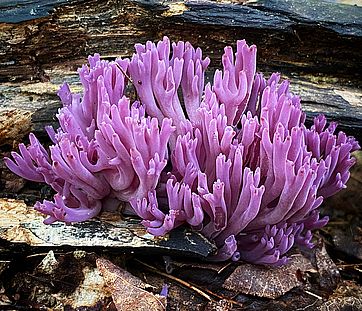
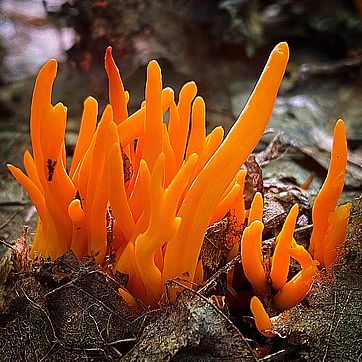
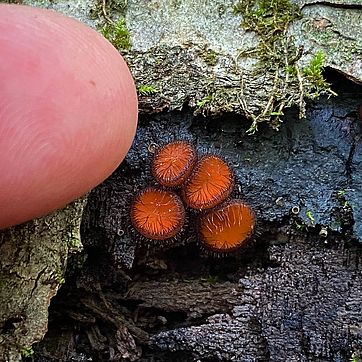
Branches of glowing violet coral fungus, Clavaria zollingeri, mingled with neon-hued spindles of orange coral fungus, Clavulinopsis aurantiocinnabarina, transforming the forest floor into a miniature, whimsical underwater reef. Eyelash cups (Scutellinia sp.), tiny scarlet discs scarcely ½ cm wide and fringed in black hairs, peered at us from damp, well-decayed logs. We found brilliant turquoise blue wood, stained by the mycelium of Chlorociboria fungus, commonly known as green elf cups for their resemblance to wee fairy goblets. Xylendein, the pigment responsible for Chloriciboria’s unique coloring, is being explored as an eco-friendly alternative to toxic dyes used in the textile industry. Large woody conks, the size and shape of horse hooves, protruded from the sides of dead-standing birch trees. I shared that this fungus, called tinder polypore (Fomes fomentarius), has long been used as both fire-starting material and as a vessel to carry live embers, a prehistoric life-hack which saved early humans the trouble of starting each new fire from scratch.
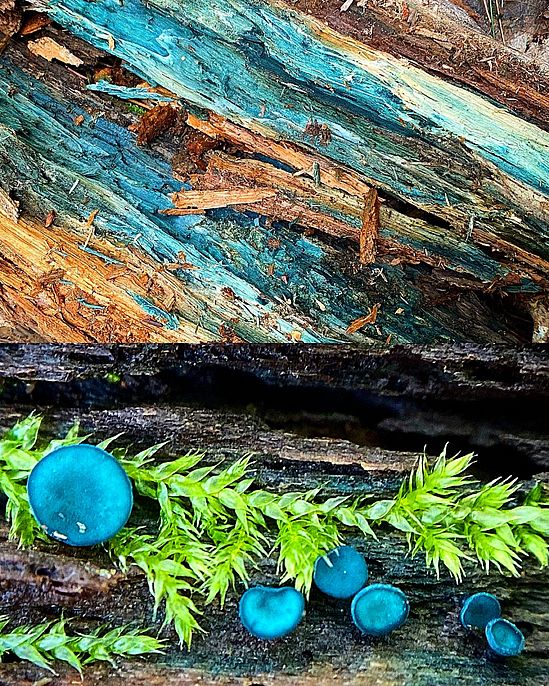
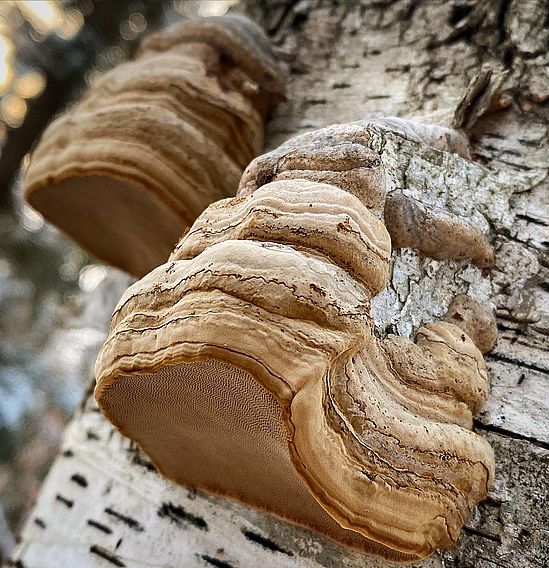
But, besides their aesthetic appeal, interesting lore, and usefulness to humans, what are all those fungi doing out there in the forest? Scientists know–and are learning more every day–that, from the miniature to the massive, each one occupies an essential niche in the ecosystem. On our walks we discussed three types of fungal roles: saprotrophic, mycorrhizal, and parasitic.
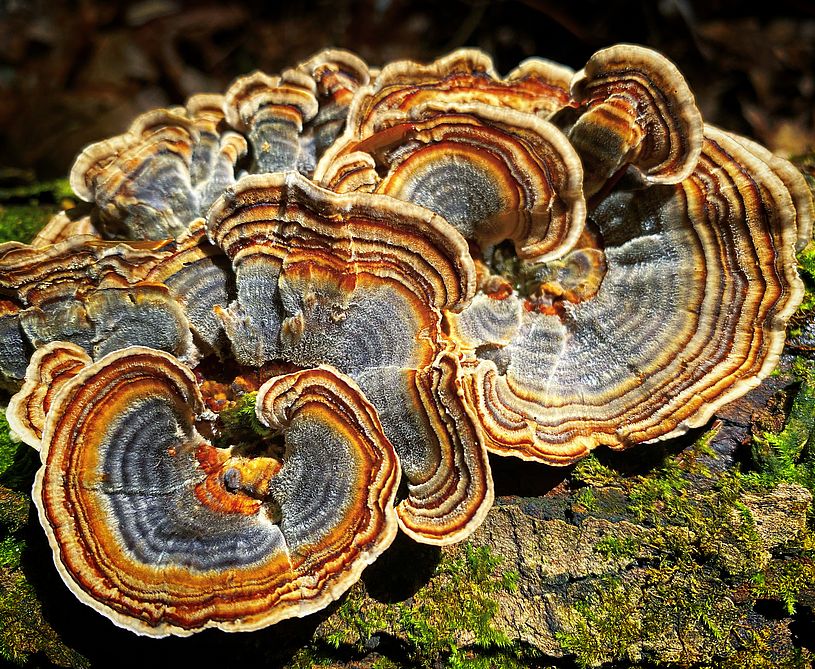
As the only multicellular organisms that can digest lignin, the tough substance that gives trees their structure, saprotrophic fungi are key members of nature’s recycling crew. Without them, wood would never decay and the earth would be buried deep in piles of dead trees and other organic matter. Saprotrophs break down these materials, releasing valuable nutrients back into the environment, making them once again available to other organisms. Turkey tails (Trametes versicolor), my personal favorite, were among the many wood-rotters that we observed that day. Overlapping clusters of beautiful turkey tail mushrooms are a familiar sight on hardwood logs and stumps throughout Vermont forests. The common name comes from their resemblance to the fanned-out tail of a strutting wild tom turkey, while the species name, versicolor, means “many-colored” and refers to the wide array of colors–including shades of brown, gray, lavender, and even blue–arranged in concentric bands on the mushroom’s caps.
Mycorrhizal fungi have been getting some much-deserved attention thanks to the buzz generated, in part, by recently published books such as Entangled Life by Merlin Sheldrake and Finding The Mother Treeby Suzanne Simard. It is thought that approximately 90% of land plants are in a mutualistic relationship with fungal partners, connected through their roots to mycelium–the fine net of thread-like tissue, largely hidden from our view in wood and soil–that forms the mass of a fungus. In this ancient bartering system, the fungus, which cannot make its own food, receives sugars which the plant produces during photosynthesis. In return, the trees tapped into this massive mycelial network (sometimes referred to as “The Wood Wide Web”) benefit from increased access to water and nutrients. It is thought that hundreds of trees may be connected in this way, and that the largest of these trees–Mother Trees–even favor their own seedlings, sending them extra resources in times of stress.
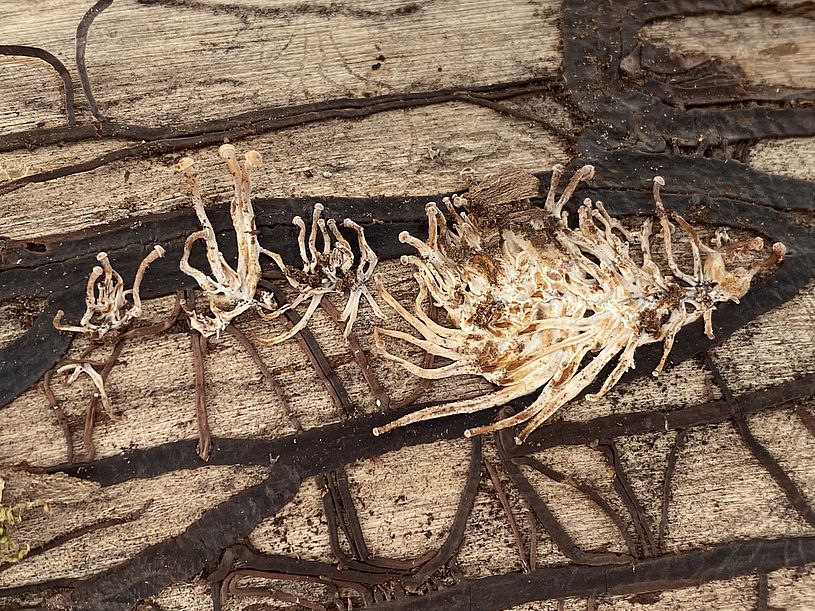
Even parasitic fungi, which were previously thought only to be destructive, can benefit the forest community. While it was too early in the year to observe the fall fruiting bodies of honey mushrooms (Armillaria species), we did find their rhizomorphs–thick, black, root-like bundles of mycelium by which the fungus spreads. An organism with a reputation as a significant pathogen, honey fungi can cause economic damage in landscaped areas, orchards, and monoculture plantations, but in natural, diverse forests rarely cause serious damage to healthy, established trees. Instead, honey fungi aid in culling trees already compromised by pests and disease, creating openings in the canopy and new opportunities for life to thrive on the forest floor. Furthermore, honey fungi have the ability to switch roles from parasite to saprotroph, recycling dead wood into nutrient-rich soil. Another common parasitic shelf fungus, lumpy bracket (Trametes gibbosa), causes a white rot of hardwood trees. Beetle larvae feeding on the rotting wood attract woodpeckers which excavate for the insects, leaving behind cavities which provide valuable habitat for other animals.
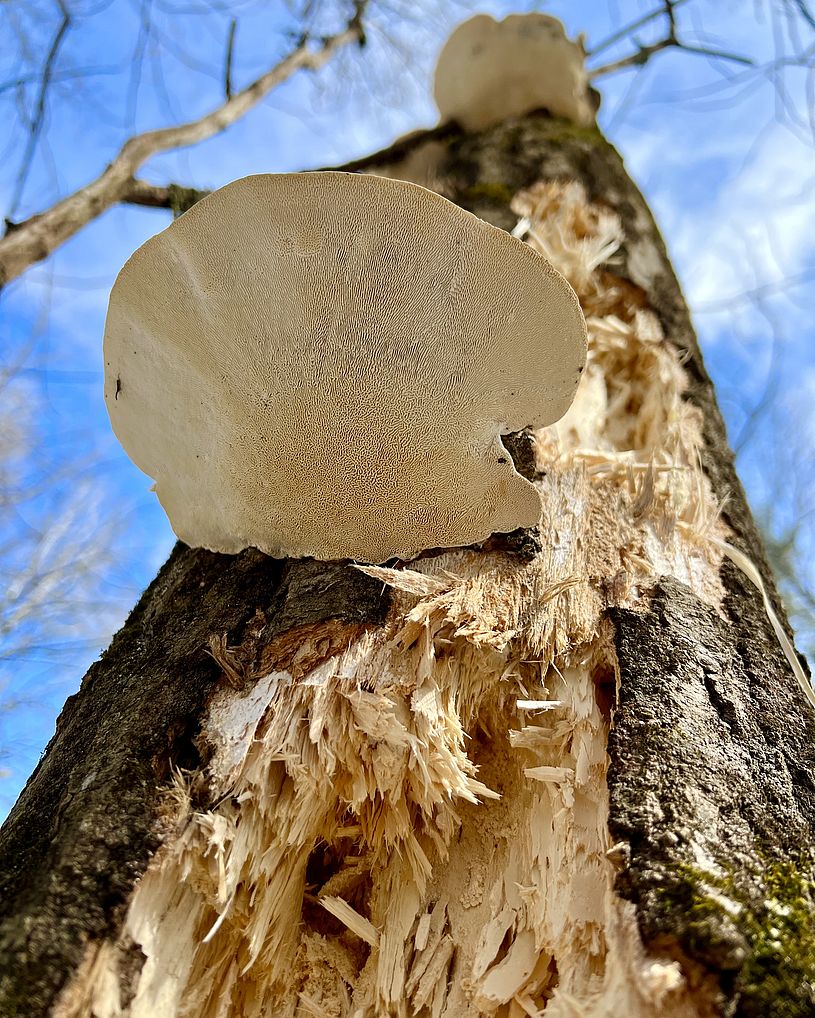
Why is fungal biodiversity important to Vermont’s natural communities? Fungi are critical to the health of an environment, each species playing a vital role–as important as the next–from the complex cycling of nutrients, to forming mutualistic relationships with plants, and connecting organisms via vast mycelial networks. But there is much to be learned about Vermont’s fungi. As of the writing of this article the state does not have an official inventory of fungi species, but mycologists, including myself, are working to build one. As part of this effort, I have created an iNaturalist project which automatically collects all fungi observations within the state. Through education and community science workshops I hope to encourage more of Vermont’s naturalists–from trained scientists to weekend nature enthusiasts–to upload their fungal finds to iNaturalist, documentation which will help elucidate what species are present, in what numbers, and how they are distributed across the state. This data can be used to direct funding and inform conservation efforts to protect not only fungi, but potentially all life within Vermont’s natural communities–including trees, wildflowers, insects, and birds–which rely on the intricate web woven by these dynamic organisms.